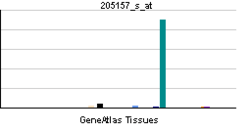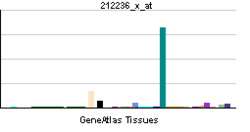Keratin 17
| KRT17 | ||||||
|---|---|---|---|---|---|---|
| Identifiers | ||||||
| Aliases | KRT17, K17, PC, PC2, PCHC1, 39.1, CK-17, keratin 17 | |||||
| External IDs | OMIM: 148069 MGI: 96691 HomoloGene: 363 GeneCards: KRT17 | |||||
| RNA expression pattern | ||||||
  | ||||||
| More reference expression data | ||||||
| Orthologs | ||||||
| Species | Human | Mouse | ||||
| Entrez | ||||||
| Ensembl | ||||||
| UniProt | ||||||
| RefSeq (mRNA) | ||||||
| RefSeq (protein) | ||||||
| Location (UCSC) | Chr 17: 41.62 – 41.62 Mb | Chr 11: 100.26 – 100.26 Mb | ||||
| PubMed search | [1] | [2] | ||||
| Wikidata | ||||||
| View/Edit Human | View/Edit Mouse |
Keratin, type I cytoskeletal 17 is a protein that in humans is encoded by the KRT17 gene.[3][4][5][6]
Keratin 17 is a type I cytokeratin. It is found in nail beds, hair follicles, sebaceous glands, and other epidermal appendages. Mutations in the gene encoding this protein lead to Jackson-Lawler type pachyonychia congenita and steatocystoma multiplex.[6]
Interactions
Keratin 17 has been shown to interact with CCDC85B.[7]
References
- ↑ "Human PubMed Reference:".
- ↑ "Mouse PubMed Reference:".
- ↑ McLean WH, Rugg EL, Lunny DP, Morley SM, Lane EB, Swensson O, Dopping-Hepenstal PJ, Griffiths WA, Eady RA, Higgins C (Jul 1995). "Keratin 16 and keratin 17 mutations cause pachyonychia congenita". Nat Genet. 9 (3): 273–8. doi:10.1038/ng0395-273. PMID 7539673.
- ↑ Troyanovsky SM, Leube RE, Franke WW (Jan 1993). "Characterization of the human gene encoding cytokeratin 17 and its expression pattern". Eur J Cell Biol. 59 (1): 127–37. PMID 1281771.
- ↑ Schweizer J, Bowden PE, Coulombe PA, Langbein L, Lane EB, Magin TM, Maltais L, Omary MB, Parry DA, Rogers MA, Wright MW (Jul 2006). "New consensus nomenclature for mammalian keratins". J Cell Biol. 174 (2): 169–74. doi:10.1083/jcb.200603161. PMC 2064177
 . PMID 16831889.
. PMID 16831889. - 1 2 "Entrez Gene: KRT17 keratin 17".
- ↑ Rual JF, Venkatesan K, Hao T, Hirozane-Kishikawa T, Dricot A, Li N, Berriz GF, Gibbons FD, Dreze M, Ayivi-Guedehoussou N, Klitgord N, Simon C, Boxem M, Milstein S, Rosenberg J, Goldberg DS, Zhang LV, Wong SL, Franklin G, Li S, Albala JS, Lim J, Fraughton C, Llamosas E, Cevik S, Bex C, Lamesch P, Sikorski RS, Vandenhaute J, Zoghbi HY, Smolyar A, Bosak S, Sequerra R, Doucette-Stamm L, Cusick ME, Hill DE, Roth FP, Vidal M (Oct 2005). "Towards a proteome-scale map of the human protein-protein interaction network". Nature. 437 (7062): 1173–8. doi:10.1038/nature04209. PMID 16189514.
Further reading
- Flohr T, Buwitt U, Bonnekoh B, Decker T, Böttger EC (1992). "Interferon-gamma regulates expression of a novel keratin class I gene". Eur. J. Immunol. 22 (4): 975–9. doi:10.1002/eji.1830220415. PMID 1372562.
- Trask DK, Band V, Zajchowski DA, Yaswen P, Suh T, Sager R (1990). "Keratins as markers that distinguish normal and tumor-derived mammary epithelial cells". Proc. Natl. Acad. Sci. U.S.A. 87 (6): 2319–23. doi:10.1073/pnas.87.6.2319. PMC 53678
 . PMID 1690428.
. PMID 1690428. - Kartasova T, Cornelissen BJ, Belt P, van de Putte P (1987). "Effects of UV, 4-NQO and TPA on gene expression in cultured human epidermal keratinocytes". Nucleic Acids Res. 15 (15): 5945–62. doi:10.1093/nar/15.15.5945. PMC 306060
 . PMID 2442723.
. PMID 2442723. - Takahashi K, Folmer J, Coulombe PA (1994). "Increased expression of keratin 16 causes anomalies in cytoarchitecture and keratinization in transgenic mouse skin". J. Cell Biol. 127 (2): 505–20. doi:10.1083/jcb.127.2.505. PMC 2120213
 . PMID 7523421.
. PMID 7523421. - Munro CS, Carter S, Bryce S, Hall M, Rees JL, Kunkeler L, Stephenson A, Strachan T (1995). "A gene for pachyonychia congenita is closely linked to the keratin gene cluster on 17q12-q21". J. Med. Genet. 31 (9): 675–8. doi:10.1136/jmg.31.9.675. PMC 1050075
 . PMID 7529318.
. PMID 7529318. - Leigh IM, Navsaria H, Purkis PE, McKay IA, Bowden PE, Riddle PN (1995). "Keratins (K16 and K17) as markers of keratinocyte hyperproliferation in psoriasis in vivo and in vitro". Br. J. Dermatol. 133 (4): 501–11. doi:10.1111/j.1365-2133.1995.tb02696.x. PMID 7577575.
- Smith FJ, Corden LD, Rugg EL, Ratnavel R, Leigh IM, Moss C, Tidman MJ, Hohl D, Huber M, Kunkeler L, Munro CS, Lane EB, McLean WH (1997). "Missense mutations in keratin 17 cause either pachyonychia congenita type 2 or a phenotype resembling steatocystoma multiplex". J. Invest. Dermatol. 108 (2): 220–3. doi:10.1111/1523-1747.ep12335315. PMID 9008238.
- Covello SP, Smith FJ, Sillevis Smitt JH, Paller AS, Munro CS, Jonkman MF, Uitto J, McLean WH (1999). "Keratin 17 mutations cause either steatocystoma multiplex or pachyonychia congenita type 2". Br. J. Dermatol. 139 (3): 475–80. doi:10.1046/j.1365-2133.1998.02413.x. PMID 9767294.
- McGowan KM, Coulombe PA (1998). "Onset of keratin 17 expression coincides with the definition of major epithelial lineages during skin development". J. Cell Biol. 143 (2): 469–86. doi:10.1083/jcb.143.2.469. PMC 2132846
 . PMID 9786956.
. PMID 9786956. - Schön M, Benwood J, O'Connell-Willstaedt T, Rheinwald JG (1999). "Human sweat gland myoepithelial cells express a unique set of cytokeratins and reveal the potential for alternative epithelial and mesenchymal differentiation states in culture". J. Cell. Sci. 112 (12): 1925–36. PMID 10341211.
- Celebi JT, Tanzi EL, Yao YJ, Michael EJ, Peacocke M (1999). "Mutation report: identification of a germline mutation in keratin 17 in a family with pachyonychia congenita type 2". J. Invest. Dermatol. 113 (5): 848–50. doi:10.1046/j.1523-1747.1999.00762.x. PMID 10571744.
- Smith FJ, Coleman CM, Bayoumy NM, Tenconi R, Nelson J, David A, McLean WH (2001). "Novel keratin 17 mutations in pachyonychia congenita type 2". J. Invest. Dermatol. 116 (5): 806–8. doi:10.1046/j.0022-202x.2001.doc.x. PMID 11348474.
- Suzuki H, Fukunishi Y, Kagawa I, Saito R, Oda H, Endo T, Kondo S, Bono H, Okazaki Y, Hayashizaki Y (2001). "Protein-protein interaction panel using mouse full-length cDNAs". Genome Res. 11 (10): 1758–65. doi:10.1101/gr.180101. PMC 311163
 . PMID 11591653.
. PMID 11591653. - Hashiguchi T, Yotsumoto S, Shimada H, Terasaki K, Setoyama M, Kobayashi K, Saheki T, Kanzaki T (2002). "A novel point mutation in the keratin 17 gene in a Japanese case of pachyonychia congenita type 2". J. Invest. Dermatol. 118 (3): 545–7. doi:10.1046/j.0022-202x.2001.01701.x. PMID 11874497.
- Terrinoni A, Smith FJ, Didona B, Canzona F, Paradisi M, Huber M, Hohl D, David A, Verloes A, Leigh IM, Munro CS, Melino G, McLean WH (2002). "Novel and recurrent mutations in the genes encoding keratins K6a, K16 and K17 in 13 cases of pachyonychia congenita". J. Invest. Dermatol. 117 (6): 1391–6. doi:10.1046/j.0022-202x.2001.01565.x. PMID 11886499.
- Scherl A, Couté Y, Déon C, Callé A, Kindbeiter K, Sanchez JC, Greco A, Hochstrasser D, Diaz JJ (2003). "Functional proteomic analysis of human nucleolus". Mol. Biol. Cell. 13 (11): 4100–9. doi:10.1091/mbc.E02-05-0271. PMC 133617
 . PMID 12429849.
. PMID 12429849. - van de Rijn M, Perou CM, Tibshirani R, Haas P, Kallioniemi O, Kononen J, Torhorst J, Sauter G, Zuber M, Köchli OR, Mross F, Dieterich H, Seitz R, Ross D, Botstein D, Brown P (2003). "Expression of cytokeratins 17 and 5 identifies a group of breast carcinomas with poor clinical outcome". Am. J. Pathol. 161 (6): 1991–6. doi:10.1016/S0002-9440(10)64476-8. PMC 1850928
 . PMID 12466114.
. PMID 12466114.
External links
This article is issued from Wikipedia - version of the 5/20/2016. The text is available under the Creative Commons Attribution/Share Alike but additional terms may apply for the media files.